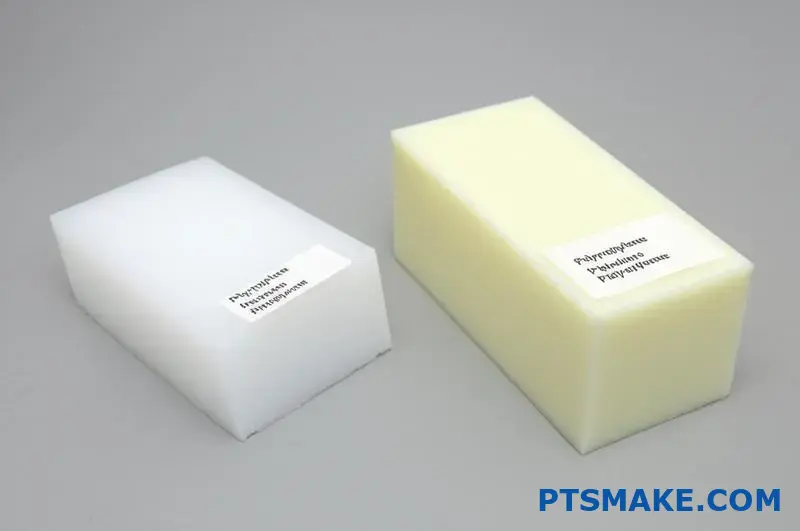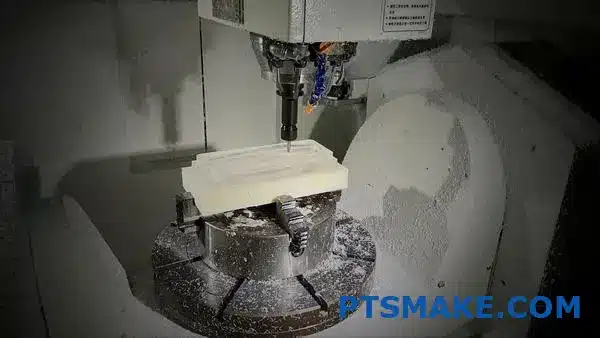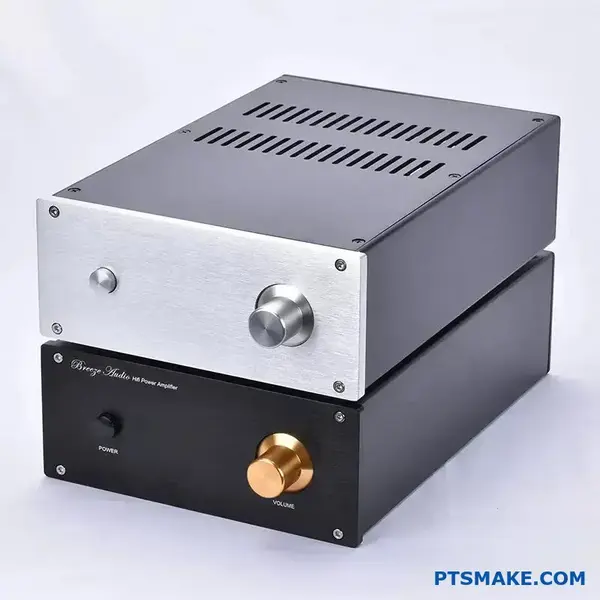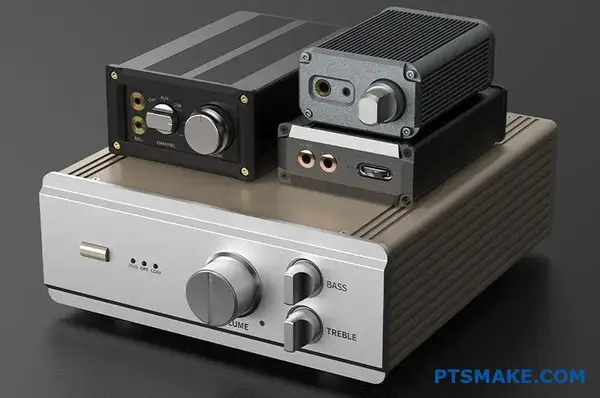## Which Is a Better HeatSink, Copper or Aluminum?
Choosing between copper and aluminum heatsinks can be confusing. Many engineers struggle with this decision when designing thermal management systems. Without the right heatsink material, your devices may overheat, reducing performance or causing premature failure – a costly mistake in product development.
Copper is the better heatsink material with thermal conductivity of 400 W/mK compared to aluminum’s 237 W/mK. However, aluminum is lighter, cheaper, and easier to manufacture, making it the preferred choice for many applications despite its lower thermal efficiency.
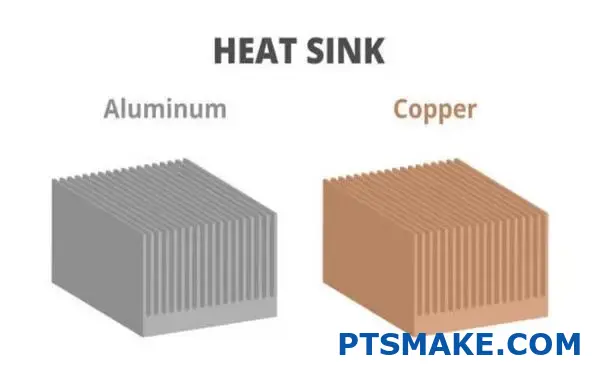
The heatsink material you choose can make or break your product’s performance. I’ve helped hundreds of clients at PTSMAKE navigate this decision based on their specific requirements. While copper offers superior thermal conductivity, aluminum provides cost-effectiveness and weight advantages. Let me walk you through the key differences to help you make the right choice for your next project.
Does Aluminum Make a Good Heat Sink?
Have you ever touched a device that shut down unexpectedly due to overheating? Or perhaps watched your laptop fan spin frantically during intensive tasks? Heat management is critical in electronics, and choosing the right heat sink material could be the difference between a reliable product and one that fails prematurely.
Aluminum does make an excellent heat sink for most applications. With a thermal conductivity of 237 W/mK, it efficiently dissipates heat while offering advantages in weight, cost, and manufacturability. Although not as thermally conductive as copper, aluminum heat sinks provide the optimal balance of performance and practicality for many thermal management solutions.
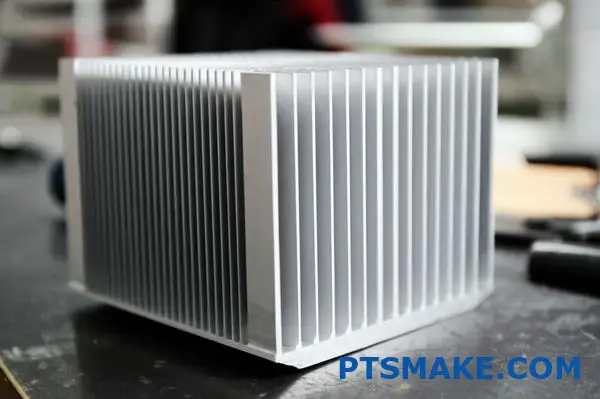
Why Thermal Management Matters
Effective thermal management is fundamental to the performance and longevity of electronic devices. As components become more powerful and compact, the challenge of dissipating heat becomes increasingly complex. In my engineering career, I’ve witnessed countless product failures stemming from inadequate heat dissipation systems.
Heat sinks function by conducting heat away from critical components and then transferring that heat to the surrounding air through convection. The efficiency of this process largely depends on the material used, with thermal conductivity being a key property.
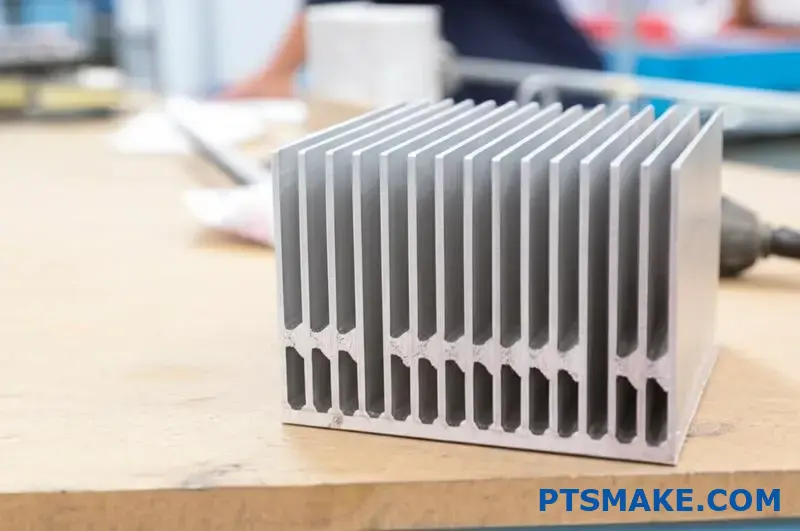
Aluminum’s Thermal Properties
Aluminum possesses a thermal conductivity of approximately 237 W/mK (watts per meter-kelvin). While this is lower than copper’s impressive 400 W/mK, it still ranks aluminum among the more thermally conductive metals commercially available. This property allows aluminum heat sinks to effectively draw heat away from electronic components.
What many engineers don’t realize is that thermal conductivity isn’t the only factor that determines heat sink performance. Specific heat capacity also plays a crucial role, and aluminum excels in this regard with a value of about 0.91 J/g·K, compared to copper’s 0.39 J/g·K. This means aluminum can absorb more heat energy per unit mass before its temperature rises.
The Density Advantage
One of aluminum’s most significant advantages is its low density, making it approximately one-third the weight of copper. When designing products where weight is a critical factor, this property becomes invaluable.
| Property | Aluminum | Copper |
|---|---|---|
| Thermal Conductivity (W/mK) | 237 | 400 |
| Density (g/cm³) | 2.7 | 8.96 |
| Specific Heat (J/g·K) | 0.91 | 0.39 |
| Relative Cost | Lower | Higher |
| Machinability | Excellent | Good |
In aerospace applications or portable electronics, where every gram matters, aluminum heat sinks provide sufficient thermal performance without adding excessive weight. At PTSMAKE, we’ve helped numerous clients optimize their designs by switching from copper to aluminum heat sinks, resulting in lighter products without compromising thermal management.
Manufacturing Considerations
Aluminum’s workability makes it exceptionally suited for heat sink manufacturing. It can be easily extruded1 into complex fin designs that maximize surface area – a critical factor for efficient heat dissipation. The material is also highly amenable to various surface treatments that can further enhance its performance.
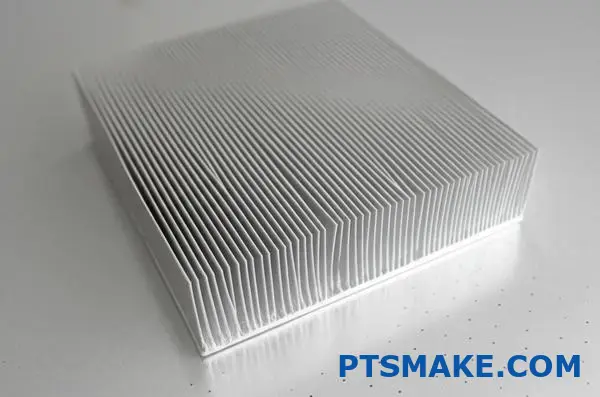
The manufacturing flexibility of aluminum allows for:
- Complex fin geometries that increase surface area
- Integrated mounting features
- Cost-effective mass production
- Excellent corrosion resistance with proper treatments
In my 15+ years of manufacturing experience, I’ve found that aluminum heat sinks can be produced with tighter tolerances and more complex features than their copper counterparts, often at a fraction of the cost.
Cost Efficiency
The economic aspect cannot be overlooked when evaluating heat sink materials. Aluminum typically costs 50-70% less than copper, making it a more budget-friendly option for large-scale production. This cost advantage, combined with its easier machinability, results in significantly lower overall manufacturing expenses.
Real-World Applications
Aluminum heat sinks dominate in several key industries:
- Consumer electronics (laptops, gaming consoles, TVs)
- LED lighting systems
- Power supplies and converters
- Telecommunications equipment
- Automotive electronics
For these applications, aluminum provides the optimal balance of thermal performance, weight, and cost. Only in the most thermally demanding scenarios, such as high-performance computing or specialized industrial equipment, does copper become necessary.
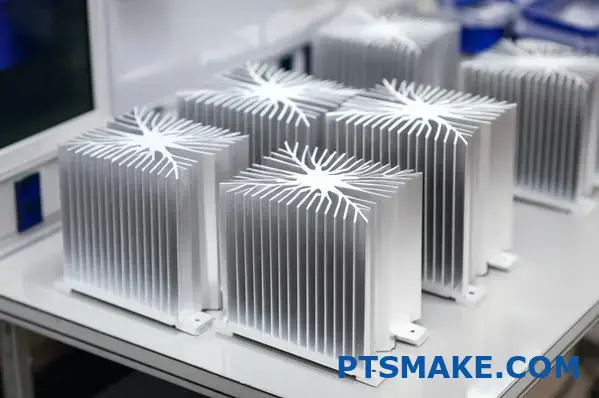
Enhancing Aluminum’s Performance
Despite its lower thermal conductivity compared to copper, aluminum heat sinks can be optimized through:
- Anodizing treatments to improve surface emissivity
- Increased surface area through fin optimization
- Forced air cooling integration
- Use of thermal interface materials to improve contact conductivity
- Heat pipe integration for extreme cooling requirements
At PTSMAKE, we often recommend aluminum heat sinks with optimized designs over basic copper options, as they typically deliver better performance-to-cost ratios for most applications.
What Material Makes the Best Heat Sink?
Ever wondered why your electronic device feels hot to the touch during intensive use? Or why some computers run cooler than others despite similar components? The secret often lies in the heat sink material—a critical decision that can determine whether your product thrives or fails in the marketplace.
The best heat sink material depends on your specific application requirements. Copper offers superior thermal conductivity (400 W/mK) but aluminum provides an excellent balance of thermal performance (237 W/mK), weight savings, cost-effectiveness, and manufacturing versatility, making it the preferred choice for most commercial applications.

The Science Behind Heat Sink Materials
When selecting the ideal heat sink material, engineers must consider multiple properties beyond just thermal conductivity. The perfect material needs to efficiently transfer heat away from critical components while meeting practical constraints like weight, cost, and manufacturability.
Thermal Conductivity: The Foundation of Heat Sink Performance
Thermal conductivity measures a material’s ability to conduct heat. While this property is fundamental, it’s just the starting point for evaluation. Among commonly available metals, silver leads with approximately 429 W/mK, followed by copper at 400 W/mK and aluminum at 237 W/mK.
| Material | Thermal Conductivity (W/mK) | Density (g/cm³) | Relative Cost | Machinability |
|---|---|---|---|---|
| Silver | 429 | 10.5 | Very High | Good |
| Copper | 400 | 8.96 | High | Good |
| Aluminum | 237 | 2.7 | Low | Excellent |
| Diamond | 2000+ | 3.5 | Prohibitive | Poor |
| Graphite | 100-500 | 2.2 | Moderate | Fair |
I’ve found that many engineers fixate on thermal conductivity alone without considering the entire thermal system. At PTSMAKE, we approach heat sink design holistically, examining how material choice affects the entire thermal management strategy.
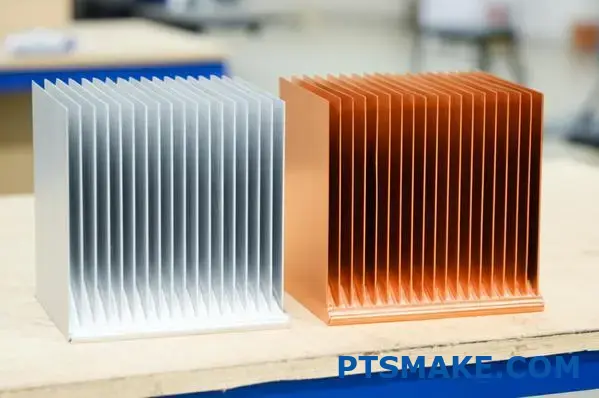
Weight Considerations: Density Matters
The density of heat sink materials significantly impacts overall product weight. Aluminum’s density (2.7 g/cm³) is approximately one-third that of copper (8.96 g/cm³), making it vastly superior for weight-sensitive applications like aerospace components, portable electronics, and drone technology.
This weight advantage cannot be overstated. When designing a laptop cooling system, for example, an aluminum heat sink allows for larger cooling surface area within the same weight constraints. This often results in better overall cooling despite aluminum’s lower thermal conductivity.
Cost-Effectiveness: The Economic Reality
The economic aspect of material selection is crucial for commercial viability. Copper typically costs 3-4 times more than aluminum, creating a significant cost differential when manufacturing at scale. This price gap widens further when considering fabrication expenses.
I’ve guided many clients through this decision process, and the cost analysis often reveals that aluminum delivers the best performance per dollar for most applications. Only in specialized scenarios with extreme thermal demands does copper’s added expense justify the marginal performance improvement.
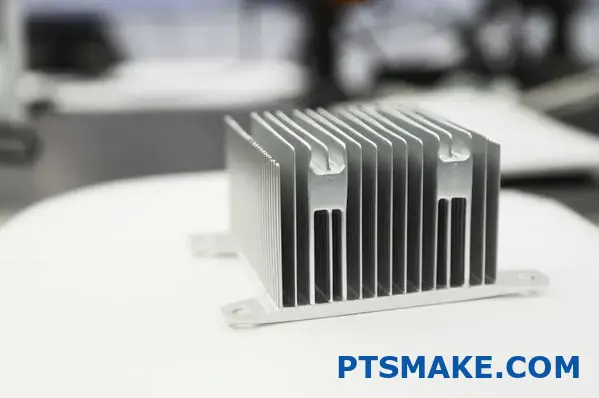
Emerging Materials in Heat Sink Technology
Carbon-Based Solutions
Carbon-based materials like graphite and diamond represent the cutting edge of thermal management. Synthetic diamond heat sinks offer astonishing thermal conductivity exceeding 2000 W/mK—five times better than copper. However, their prohibitive cost and manufacturing challenges currently limit their use to specialized applications like semiconductor cooling in research settings.
Graphite composites present a more practical alternative. With directional thermal conductivity between 100-500 W/mK, these materials can be engineered to channel heat in specific directions. Their lightweight nature (density approximately 2.2 g/cm³) makes them particularly valuable in aerospace applications.
Composite Heat Sinks: The Best of Both Worlds
Hybrid solutions often deliver superior performance by combining materials strategically. Aluminum-graphite composites, for instance, offer enhanced thermal conductivity while maintaining aluminum’s weight and cost advantages.
One innovative approach we’ve implemented at PTSMAKE involves copper-cored aluminum heat sinks. This design places copper directly beneath the heat source for maximum conductivity, while using aluminum for the extended surfaces, optimizing both performance and weight.
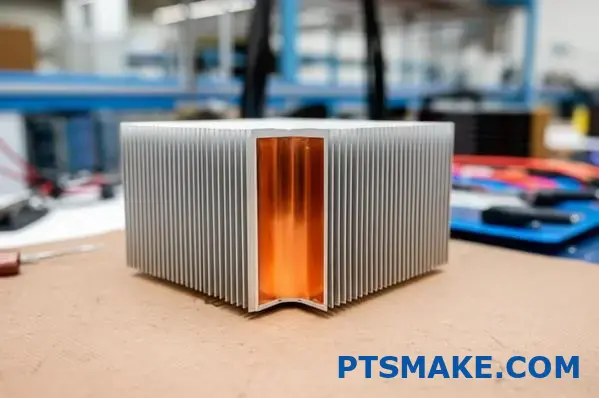
Application-Specific Considerations
Consumer Electronics
For laptops, smartphones, and other consumer devices, aluminum remains the dominant material due to its excellent balance of properties. The weight savings are crucial for portability, while its thermal performance is adequate for most consumer-grade processors when paired with proper heat sink design.
High-Performance Computing
In gaming PCs, servers, and advanced computing applications, copper heat sinks or copper-aluminum hybrids often prevail. The higher thermal loads in these systems justify copper’s premium cost. For extreme performance, we sometimes recommend vapor chamber solutions or copper heat sinks with integrated heat pipes to maximize thermal dissipation2 efficiency.
Industrial Applications
Industrial equipment frequently operates in challenging environments with sustained high temperatures. In these scenarios, material durability becomes as important as thermal properties. Aluminum’s excellent corrosion resistance gives it an edge in many industrial applications, though copper alloys with added corrosion protection are sometimes necessary for extreme conditions.
Aerospace and Military
For aerospace and military applications, the weight-to-performance ratio is paramount. Advanced aluminum alloys and composite materials typically dominate this sector, with specialized coatings to enhance surface emissivity and radiation heat transfer in vacuum or near-vacuum environments.
Manufacturing Considerations
The ease of manufacturing significantly impacts heat sink performance and cost. Aluminum’s excellent machinability allows for complex fin structures that maximize surface area—often providing better real-world cooling than simpler copper designs despite copper’s superior conductivity.
At PTSMAKE, we specialize in precision CNC machining that can create optimized fin geometries in both aluminum and copper. However, I’ve consistently observed that aluminum’s manufacturing advantages allow for more intricate designs that compensate for its lower thermal conductivity through increased surface area.
Which Is Better, a Ceramic or Aluminum Heat Sink?
Have you ever found your electronic device overheating during intensive tasks, or wondered why some devices stay cool while others become uncomfortably hot? The heat sink material used in these devices might be the key difference between reliable performance and frustrating shutdowns – but choosing between ceramic and aluminum options isn’t always straightforward.
Both ceramic and aluminum heat sinks have their place in thermal management. Aluminum heat sinks offer higher thermal conductivity (237 W/mK), easier manufacturing, and cost-effectiveness, while ceramic heat sinks provide electrical insulation, corrosion resistance, and better performance in specialized applications where electrical isolation is critical.
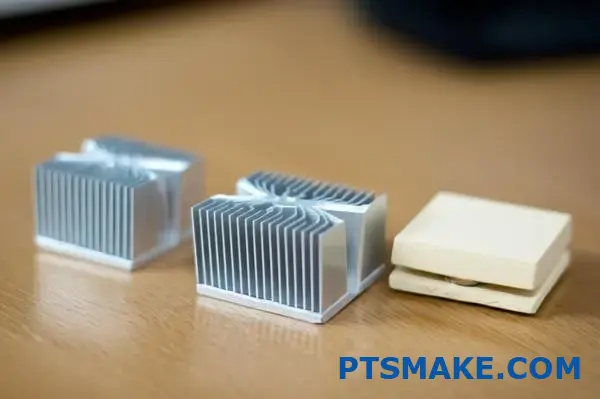
The Fundamental Differences Between Ceramic and Aluminum Heat Sinks
When designing thermal management systems, understanding the core differences between ceramic and aluminum heat sinks is essential for making the right choice. These materials have distinct properties that make each suitable for specific applications.
Thermal Conductivity Comparison
Thermal conductivity is perhaps the most critical property of any heat sink material. It measures how efficiently a material can transfer heat away from its source.
| Material | Thermal Conductivity (W/mK) | Relative Cost | Electrical Properties | Weight |
|---|---|---|---|---|
| Aluminum | 237 | Low-Moderate | Conductive | Light (2.7 g/cm³) |
| Aluminum Nitride (Ceramic) | 170-200 | High | Insulating | Moderate (3.26 g/cm³) |
| Beryllia (Ceramic) | 250-300 | Very High | Insulating | Light (3.01 g/cm³) |
| Aluminum Oxide (Ceramic) | 20-30 | Moderate | Insulating | Moderate (3.95 g/cm³) |
Aluminum’s thermal conductivity of 237 W/mK makes it an excellent heat conductor. By comparison, ceramic materials vary widely in their thermal properties. Aluminum nitride ceramics can reach 170-200 W/mK, beryllia ceramics can achieve 250-300 W/mK (even outperforming aluminum), while aluminum oxide ceramics typically range from 20-30 W/mK.
In my experience working with various cooling solutions, this difference becomes particularly noticeable in high-power applications. When we designed cooling systems for power electronics at PTSMAKE, aluminum consistently delivered better thermal performance than standard aluminum oxide ceramics, though specialized ceramic options like beryllia could match or exceed it.
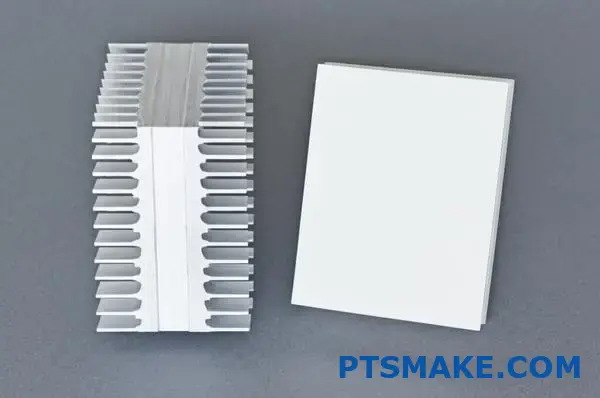
Electrical Insulation Properties
One major advantage ceramic heat sinks have over aluminum is their natural electrical insulation. Ceramics are excellent electrical insulators, with typical dielectric strengths ranging from 10-20 kV/mm.
This property makes ceramic heat sinks invaluable in applications where electrical isolation is critical. For example, when working with high-voltage components, the risk of electrical shorting through an aluminum heat sink requires additional insulating layers, which introduce thermal resistance. Ceramic heat sinks eliminate this concern entirely.
Weight and Density Considerations
Aluminum’s low density (approximately 2.7 g/cm³) gives it a significant weight advantage over most ceramics. This makes aluminum heat sinks particularly suitable for weight-sensitive applications like portable electronics, drones, and aerospace components.
Ceramic materials generally have higher densities, ranging from 3.0 to 4.0 g/cm³ depending on the specific ceramic. This difference might seem small, but it adds up in applications where multiple heat sinks are used or where weight is a critical design factor.
Manufacturing Complexity and Cost Factors
The manufacturing process for aluminum and ceramic heat sinks differs significantly, affecting both cost and design flexibility.
Aluminum Heat Sink Manufacturing
Aluminum heat sinks can be produced through various methods:
- Extrusion – Cost-effective for creating complex fin structures
- Die-casting – Excellent for high-volume production
- CNC machining – Provides precision for complex designs
- Stamping – Simple, economical for basic heat sink shapes
At PTSMAKE, we’ve optimized our CNC machining processes for aluminum heat sinks, allowing us to create intricate fin patterns that maximize surface area while maintaining tight tolerances. This manufacturing flexibility is a key advantage of aluminum.
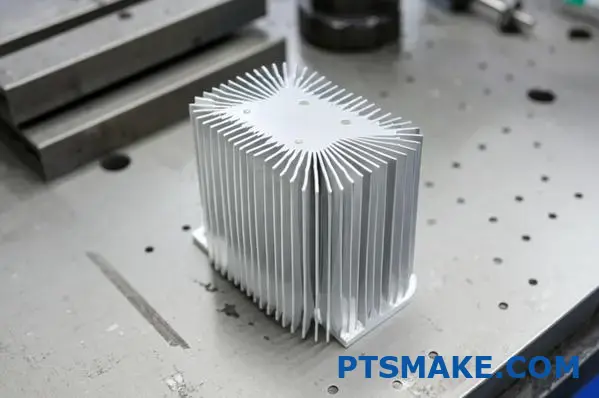
Ceramic Heat Sink Manufacturing
Ceramic heat sinks typically involve more complex manufacturing processes:
- Powder preparation and pressing
- Sintering at high temperatures
- Precision grinding and finishing
- Often requiring specialized equipment
These processes make ceramic heat sinks significantly more expensive to produce, especially for custom designs. The manufacturing limitations also restrict the complexity of fin structures and surface features that can be achieved cost-effectively.
Cost Comparison
The cost differential between aluminum and ceramic heat sinks can be substantial:
- Aluminum heat sinks are typically the most economical option
- Standard ceramic heat sinks (aluminum oxide) cost approximately 2-3 times more than aluminum
- High-performance ceramic options (beryllia, aluminum nitride) can cost 5-10 times more than aluminum
This cost difference becomes particularly significant in high-volume production, where material choices dramatically impact overall project budgets.
Application-Specific Advantages
When Aluminum Heat Sinks Excel
Aluminum heat sinks generally perform better in:
- Consumer electronics (laptops, gaming consoles, TVs)
- Applications where weight is critical
- Cost-sensitive products
- Designs requiring complex fin structures
- Scenarios where thermal conductivity is the primary concern
The versatility of aluminum makes it the go-to choice for approximately 80% of the heat sink projects we handle at PTSMAKE. Its combination of thermal performance, weight, and cost advantages makes it suitable for most mainstream applications.
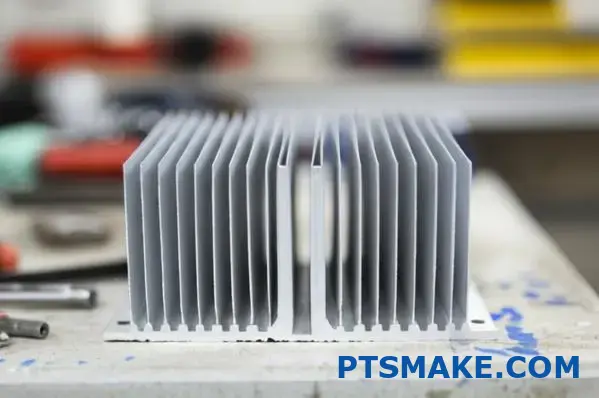
When Ceramic Heat Sinks Are Preferable
Ceramic heat sinks offer clear advantages in:
- High-voltage electronics requiring electrical isolation
- Corrosive environments where aluminum would degrade
- RF and microwave applications requiring low signal interference
- Medical devices where biocompatibility matters
- Systems operating at extremely high temperatures (>400°C)
I’ve found ceramic heat sinks particularly valuable in specialized electronics like power supplies and high-voltage amplifiers, where the electrical isolation properties justify the additional cost.
Thermal Interface Considerations
The interface between the heat source and heat sink significantly impacts overall cooling performance. This is where some interesting differences between aluminum and ceramic emerge.
Aluminum heat sinks typically require a thermal interface material (TIM) – usually a paste, pad, or adhesive – to maximize thermal conductivity at the contact point. The thermal resistance3 at this interface can reduce overall cooling efficiency.
Ceramic heat sinks, particularly those made from aluminum nitride, can sometimes be directly bonded to certain electronic components, eliminating the need for additional thermal interface materials. This direct bonding can potentially improve thermal transfer efficiency in specialized applications.
Environmental Considerations and Sustainability
Regarding environmental impact and sustainability:
- Aluminum is highly recyclable (up to 95% energy savings compared to primary production)
- Ceramic materials are generally more energy-intensive to produce
- Aluminum production has a higher initial environmental footprint
- Ceramics are typically more durable and corrosion-resistant, potentially offering longer service life
For companies prioritizing sustainable manufacturing, the recyclability of aluminum represents a significant advantage, though the energy-intensive initial production somewhat offsets this benefit.
Making the Right Choice for Your Application
Selecting between ceramic and aluminum heat sinks requires careful consideration of your specific requirements:
- Prioritize aluminum for general-purpose cooling where cost and weight matter
- Choose ceramic when electrical isolation is critical or in specialized applications
- Consider hybrid solutions (ceramic-coated aluminum) for balanced performance
- Evaluate the entire thermal system, not just the heat sink material
- Factor in environmental conditions, including temperature extremes and corrosion risks
At PTSMAKE, we help clients navigate these decisions by analyzing their specific thermal management requirements and recommending the most suitable material based on a comprehensive evaluation of performance, cost, and practical considerations.
What Is the Best Material for LED Heat Sink?
Have you ever wondered why some LED lights burn out quickly while others last for years? Or why some LED fixtures feel uncomfortably hot to touch while others remain cool? The secret often lies in the heat sink material – a critical component that can make or break your LED lighting system’s performance and lifespan.
Aluminum is generally the best material for LED heat sinks, offering an optimal balance of thermal conductivity (237 W/mK), lightweight properties, excellent manufacturability, and cost-effectiveness. While copper provides superior thermal conductivity (400 W/mK), aluminum’s practical advantages make it the preferred choice for most commercial LED applications.
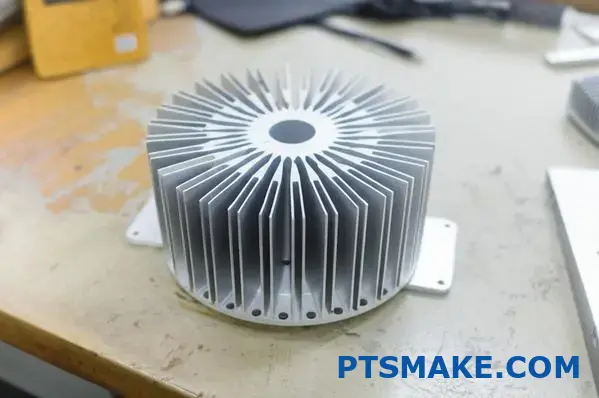
Understanding Thermal Management in LED Systems
Managing heat is critical for LED performance and longevity. Unlike traditional lighting, LEDs don’t emit heat as infrared radiation but instead generate heat that must be conducted away from the junction. Effective thermal management directly impacts:
- LED lifespan (potentially extending from 50,000 to 100,000+ hours)
- Light output and efficiency
- Color stability and consistency
- Overall system reliability
The heart of any LED thermal management system is the heat sink, which conducts heat away from the LED junction and dissipates it into the surrounding environment. The material selection for this component is not a decision to take lightly.
Key Properties for LED Heat Sink Materials
When evaluating heat sink materials for LED applications, several properties come into play:
| Property | Importance | Impact on Performance |
|---|---|---|
| Thermal Conductivity | High | Determines how quickly heat moves away from LED |
| Density/Weight | Medium | Affects installation options and structural requirements |
| Cost | Medium-High | Influences overall product economics |
| Manufacturability | High | Determines what geometries and features are possible |
| Corrosion Resistance | Medium | Impacts longevity in various environments |
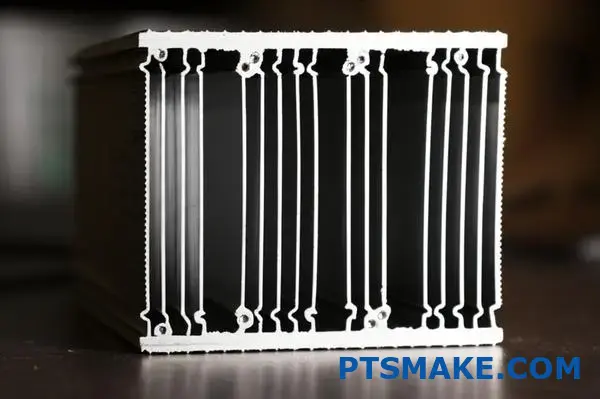
Aluminum: The Industry Standard
Aluminum alloys (particularly 6063-T5 and 1050) have become the dominant material for LED heat sinks for good reason. With a thermal conductivity of approximately 237 W/mK, aluminum offers excellent heat dissipation capabilities while providing significant advantages in other areas.
The Weight Advantage
At 2.7 g/cm³, aluminum is approximately one-third the weight of copper (8.96 g/cm³). This property makes aluminum heat sinks particularly valuable in:
- Ceiling-mounted fixtures where weight affects installation requirements
- Track lighting systems that must support multiple fixtures
- Portable or handheld LED devices
- Architectural lighting where heat sinks may need to be suspended
In my years designing thermal solutions for LED manufacturers, I’ve found that the weight factor often becomes decisive when scaling up to commercial deployments. A client once switched from copper to aluminum heat sinks for their retail lighting project, reducing overall fixture weight by 58% and saving significantly on installation costs.
Copper: Superior Thermal Performance
With a thermal conductivity of approximately 400 W/mK, copper outperforms aluminum by nearly 70% in pure heat transfer capability. This makes copper theoretically superior for high-power LED applications where thermal management is particularly challenging.
However, copper comes with significant trade-offs:
- Much higher material cost (typically 3-4 times more expensive than aluminum)
- Greater weight (approximately 3 times heavier than aluminum)
- More difficult to extrude into complex shapes
- Tends to oxidize over time, requiring surface treatments
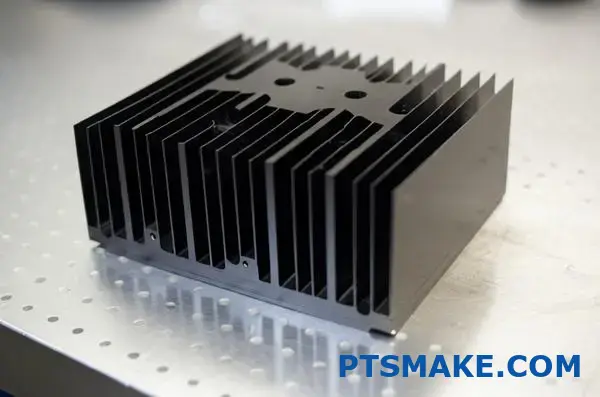
Niche Applications for Copper
Despite these limitations, copper heat sinks find their place in specialized LED applications:
- Ultra-high-power LED systems where thermal performance is absolutely critical
- Compact designs where space constraints limit heat sink size
- High-end architectural lighting where cost is less of a concern
- Applications where the natural patina of copper is desired aesthetically
Composite and Emerging Materials
The LED heat sink market has seen innovation through composite materials that aim to combine the best properties of different materials:
Copper-Aluminum Composites
These hybrid solutions typically feature a copper core (for excellent thermal conductivity at the LED contact point) with aluminum fins (for weight and cost reduction). The manufacturing process usually involves friction welding or brazing to join the different metals.
This approach creates a "best of both worlds" solution where copper efficiently pulls heat away from the LED junction, while aluminum provides the large surface area needed for convection cooling at a reasonable weight and cost.
Thermally Conductive Plastics
Recent advancements have produced specialized polymers with thermal conductivities between 10-30 W/mK. While significantly lower than metals, these materials offer:
- Extreme light weight
- Complex moldable geometries
- Electrical insulation properties
- Potential cost advantages in high-volume production
At PTSMAKE, we’ve worked with several LED manufacturers to develop prototype plastic heat sinks for low to medium power applications. While not suitable for high-power LEDs, these materials excel in consumer-grade lighting where moderate heat dissipation is sufficient.
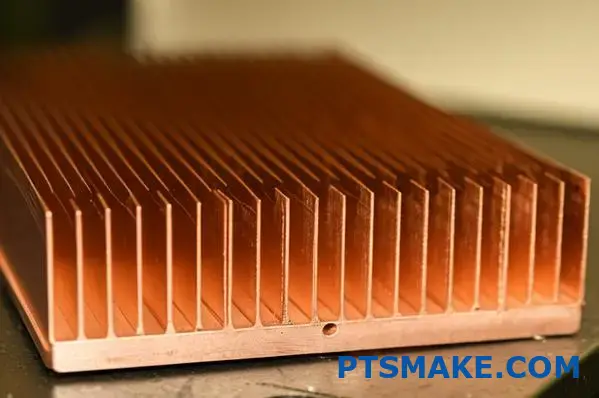
Manufacturing Considerations
The best heat sink material is only as good as your ability to manufacture it effectively. This is where aluminum truly shines for LED applications.
Extrusion Excellence
Aluminum’s extrudability allows for the creation of complex fin structures that maximize surface area – a critical factor for convection cooling. The extrusion process enables:
- Tight fin spacing (as low as 1.5mm between fins)
- Variable fin heights and thicknesses
- Integrated mounting features
- Consistent cross-sections across long lengths
This manufacturing flexibility often enables aluminum heat sinks to outperform theoretical expectations. By optimizing surface area and fin design, an aluminum heat sink can sometimes dissipate more heat than a simpler copper design, despite copper’s superior conductivity.
CNC Machining Capabilities
For custom or complex LED heat sink designs, CNC machining offers tremendous flexibility. At PTSMAKE, we specialize in precision-machined aluminum heat sinks that can incorporate:
- Custom mounting interfaces
- Integrated wire channels
- Variable fin patterns optimized for specific airflow conditions
- Hybrid designs combining extrusion and machined features
Aluminum’s excellent machinability makes it ideal for these applications, allowing for tight tolerances and complex geometries that would be challenging or prohibitively expensive with copper.
Cost Considerations in Real-World Applications
In commercial LED lighting, the cost equation extends beyond raw material prices. When evaluating the total economic picture:
- Material costs (aluminum typically offers 65-75% savings over copper)
- Manufacturing costs (aluminum is generally less expensive to process)
- Shipping costs (aluminum’s lighter weight reduces freight expenses)
- Installation costs (lighter fixtures require less robust mounting hardware)
These factors combine to make aluminum the economically sensible choice for most LED applications. The thermal performance difference rarely justifies copper’s significant cost premium except in the most demanding scenarios.
Making the Right Selection for Your LED Application
Based on my experience working with numerous LED manufacturers, here’s a practical decision framework for selecting heat sink materials:
- For general commercial lighting: Aluminum (6063-T5 alloy)
- For cost-sensitive consumer products: Aluminum (1050 series)
- For high-power density applications: Copper or copper-aluminum composites
- For ultralight requirements: Thermally enhanced polymers (low-power LEDs only)
- For outdoor/marine environments: Anodized aluminum or phase-change materials4 for extreme conditions
The reality is that for approximately 90% of LED applications, properly designed aluminum heat sinks provide the optimal balance of thermal performance, weight, manufacturability, and cost-effectiveness.
What Grade Aluminum Is Used for Heat Sinks?
Ever struggled with overheating electronics or wondered why some devices run cool while others seem to melt down? The aluminum grade in your heat sink could be the difference between reliable performance and premature failure—but with so many alloy options available, how do you know which one is right for your thermal management needs?
The most common aluminum grades used for heat sinks are 6061-T6 and 6063-T5, with thermal conductivities of 167 W/mK and 209 W/mK respectively. While 1050A offers superior thermal performance (229 W/mK), the 6000-series alloys provide better mechanical strength and extrudability, creating the optimal balance of thermal efficiency and manufacturing versatility for most applications.
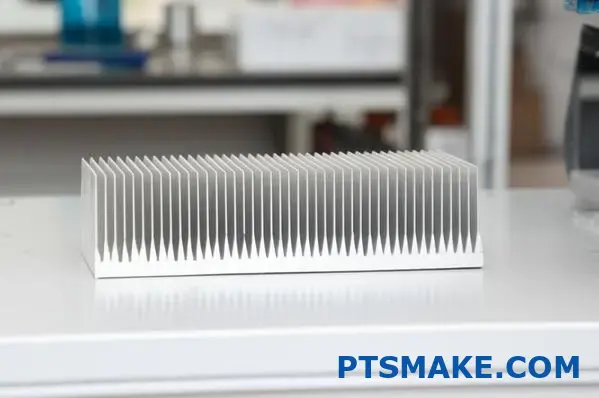
Understanding Aluminum Alloy Designations for Heat Sinks
When selecting aluminum for heat sinks, understanding the alloy designation system is crucial. The first digit indicates the primary alloying element, while subsequent numbers provide more specific information about composition.
The 1000 Series: Maximum Thermal Conductivity
The 1000 series represents nearly pure aluminum (99%+ purity), with alloys like 1050A and 1070 being popular choices for heat sinks that prioritize thermal performance above all else.
| Alloy | Thermal Conductivity (W/mK) | Relative Cost | Strengths | Limitations |
|---|---|---|---|---|
| 1050A | 229-235 | Moderate | Excellent thermal conductivity, Good corrosion resistance | Lower mechanical strength, Less suitable for complex extrusions |
| 1070 | 225-229 | Moderate-High | Very high thermal conductivity | Poor machinability, Limited structural applications |
| 6061-T6 | 167-173 | Low-Moderate | Excellent machinability, Good strength | Lower thermal conductivity than 1000 series |
| 6063-T5 | 209-218 | Low | Superior extrudability, Good thermal performance | Moderate strength compared to 6061 |
The 1000 series excels in applications where thermal conductivity is the absolute priority and mechanical requirements are minimal. However, their softer nature makes them less ideal for complex fin structures or applications requiring substantial mechanical strength.
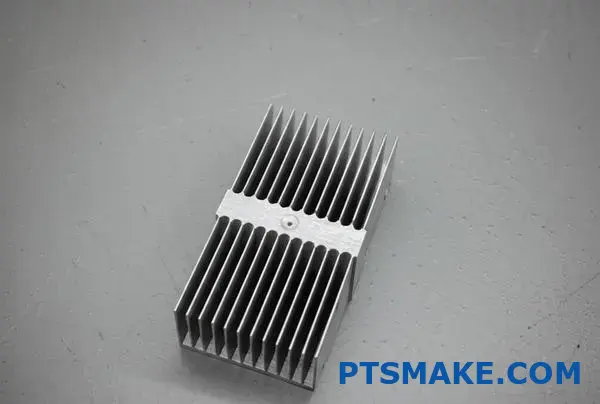
The 6000 Series: The Versatile Standard
The 6000 series alloys, particularly 6061-T6 and 6063-T5, have become the industry standard for heat sink applications. These aluminum-magnesium-silicon alloys offer an excellent balance of properties:
6061-T6: With a thermal conductivity of approximately 167 W/mK, this alloy provides excellent machinability, good corrosion resistance, and superior mechanical properties. The T6 temper designation indicates the material has been solution heat-treated and artificially aged to maximize strength.
6063-T5: Offering higher thermal conductivity (209 W/mK) than 6061, this alloy is specifically formulated for extrusion processes. The T5 temper indicates it’s been artificially aged after extrusion. This combination makes it ideal for heat sinks with complex fin geometries that maximize surface area.
In my 15+ years at PTSMAKE, I’ve found that 6063-T5 represents the sweet spot for most commercial heat sink applications. Its superior extrudability allows us to create intricate fin structures with thin walls and tight spacing, significantly increasing surface area for better convection cooling.
Thermal Performance Considerations
When evaluating aluminum grades for heat sink applications, thermal conductivity is certainly important, but it’s not the whole story. The overall thermal performance depends on multiple factors:
Thermal Conductivity vs. Surface Area
A common misconception is that the highest thermal conductivity always translates to the best heat sink performance. In reality, the ability to create complex geometries with more surface area often outweighs the benefits of marginally higher conductivity.
Take this practical example: A heat sink made from 6063-T5 aluminum can typically incorporate 30-40% more surface area through complex fin structures compared to a simpler design in 1050A aluminum. This additional surface area often more than compensates for the approximately 10% lower thermal conductivity.
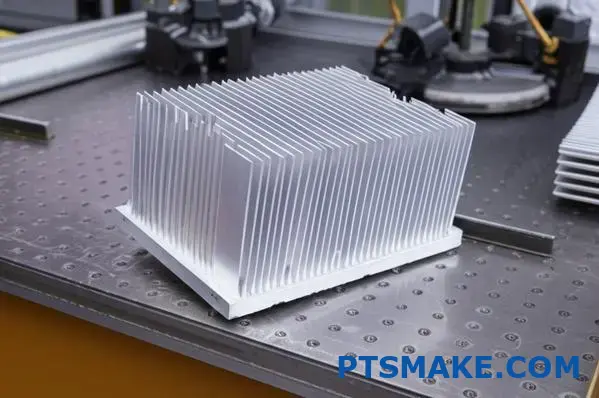
Surface Treatments and Their Impact
The surface treatment of aluminum heat sinks can significantly affect thermal performance:
Anodizing: While primarily used for corrosion protection and aesthetics, anodizing slightly reduces thermal conductivity (typically 1-3%) but can increase emissivity by up to 80%, improving radiative heat transfer.
Black Anodizing: Particularly beneficial for radiation-dominant cooling scenarios, increasing emissivity to 0.8-0.9 compared to 0.03-0.05 for bare aluminum.
Chromate Conversion Coatings: Minimal impact on thermal performance while providing good corrosion protection.
At PTSMAKE, we often recommend black anodized 6063-T5 for applications where both conductive and radiative heat transfer are important, as the emissivity benefits typically outweigh the slight reduction in thermal conductivity.
Manufacturing Considerations
The manufacturability of different aluminum grades significantly impacts heat sink design and performance:
Extrusion Capabilities
The 6063 alloy was specifically developed for the extrusion process, offering exceptional formability. This allows for:
- Fin thicknesses as low as 0.8mm
- Aspect ratios (height-to-thickness) exceeding 20:1
- Complex cross-sections that maximize surface area
- Tight tolerances on critical dimensions
Machining Characteristics
For heat sinks requiring post-extrusion machining or those manufactured entirely through CNC processes:
- 6061-T6 offers superior machinability with excellent chip formation and surface finish
- 1050A tends to be "gummy" during machining, making precise features more challenging
- 6063-T5 provides good machinability, though not quite as good as 6061-T6
Die Casting Options
For high-volume production with complex three-dimensional features, die cast aluminum alloys like A380 (AlSi8Cu3) offer:
- Ability to create complex 3D geometries not possible with extrusion
- Good thermal conductivity (approximately 96-130 W/mK)
- Cost-effective high-volume production
- Moderate to good corrosion resistance
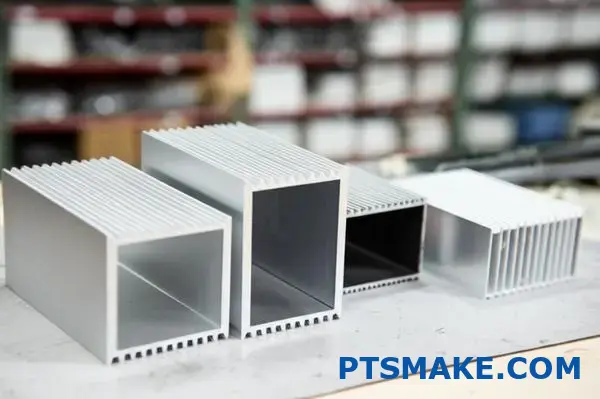
Application-Specific Selection Guide
Different applications have unique requirements that influence the optimal aluminum grade choice:
Consumer Electronics
For laptops, gaming consoles, and similar devices, 6063-T5 typically provides the best balance of properties:
- Good thermal conductivity
- Excellent extrudability for maximizing surface area
- Lightweight design
- Cost-effective manufacturing
Power Electronics
For high-power applications like motor drives, power supplies, and renewable energy systems:
- 6061-T6 offers the mechanical strength needed for larger heat sinks
- 1050A may be used at critical contact points where maximum thermal conductivity is essential
- Hybrid approaches combining multiple alloys can be effective
LED Lighting
LED applications have unique considerations:
- 6063-T5 is ideal for passive cooling with its excellent extrudability for creating radial fin patterns
- 1050A might be used for the central contact area to maximize heat transfer from the LED source
- Anodized surfaces (particularly black) enhance radiative cooling in enclosed fixtures
Aerospace and Military
For these demanding applications:
- 6061-T6 provides the mechanical integrity needed for vibration resistance
- Special high-strength alloys like 7075-T6 might be used when structural requirements are paramount
- Surface treatments must be carefully selected to meet specific environmental requirements
Cost-Benefit Analysis
When evaluating aluminum grades for heat sinks, the cost considerations extend beyond raw material prices:
Material Costs: 1000 series alloys typically cost 10-15% more than 6000 series alloys.
Manufacturing Costs: The easier extrudability of 6063 can reduce manufacturing costs by 20-30% compared to 1050A for complex designs.
Performance Trade-offs: The theoretical 15-20% better thermal conductivity of 1050A rarely translates to equivalent real-world cooling improvement due to design limitations.
Volume Considerations: For high-volume production, the manufacturing advantages of 6063-T5 typically make it more economical despite slightly lower thermal performance.
Emerging Trends and Future Developments
The heat sink industry continues to evolve with several notable trends:
Microalloyed Aluminum: New aluminum alloys specifically engineered for thermal management applications are emerging, offering improved combinations of thermal conductivity and mechanical properties.
Composite Materials: Aluminum-graphite composites and metal matrix composites (MMCs) are gaining popularity for specialized applications, offering directional thermal conductivity that can be optimized for specific heat flow paths.
Advanced Manufacturing: Techniques like selective laser melting (SLM) are enabling previously impossible heat sink geometries, potentially changing the calculus for aluminum grade selection.
Vapor Chamber Integration: Heat sinks with integrated vapor chambers are becoming more common, where the aluminum grade selected needs to be compatible with the vapor chamber’s condensation cycle5 requirements.
In my experience at PTSMAKE, we’re increasingly seeing designers move beyond simplistic material selection to instead focus on the overall thermal system design. The best aluminum grade is ultimately the one that enables the optimal combination of thermal performance, manufacturability, and cost for your specific application.
How Does Surface Finishing Affect Aluminum Heat Sink Performance?
Have you ever noticed how the same electronic device can run hot in one instance and cooler in another? Or wondered why manufacturers treat the surfaces of heat sinks differently? The secret might lie in the surface finishing – a critical yet often overlooked aspect that can dramatically impact how well your aluminum heat sink performs.
Surface finishing significantly affects aluminum heat sink performance by altering thermal emissivity, contact resistance, and airflow dynamics. Anodized surfaces increase emissivity by 5-8 times over bare aluminum, enhancing radiative heat transfer. While bare aluminum offers slightly better conductive performance, treatments like black anodizing, powder coating, and chromate conversion each offer unique performance benefits for specific applications.
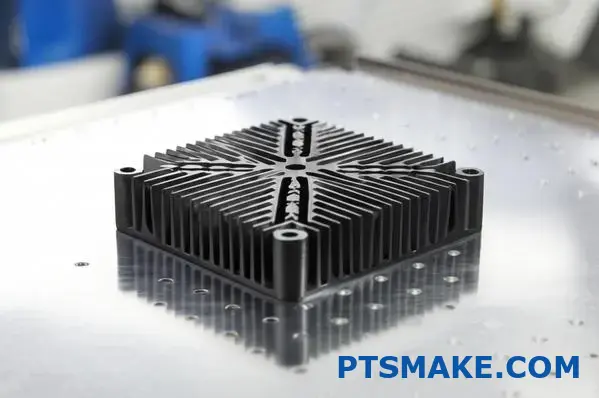
The Science Behind Surface Finishing and Thermal Performance
Surface finishing does more than just change a heat sink’s appearance – it fundamentally alters how heat transfers from the aluminum to the surrounding environment. Understanding these effects requires examining the three primary heat transfer mechanisms: conduction, convection, and radiation.
Impact on Thermal Emissivity
One of the most significant ways surface finishing affects heat sink performance is by changing the thermal emissivity of the aluminum surface. Emissivity measures how effectively a surface emits thermal radiation compared to a perfect black body.
| Surface Treatment | Typical Emissivity | Relative Improvement Over Bare Aluminum |
|---|---|---|
| Bare/Polished Aluminum | 0.04-0.06 | Baseline |
| Clear Anodizing | 0.15-0.25 | 3-5× improvement |
| Black Anodizing | 0.80-0.90 | 15-20× improvement |
| Black Powder Coating | 0.90-0.95 | 18-22× improvement |
| Chemical Conversion | 0.10-0.15 | 2-3× improvement |
This dramatic increase in emissivity with certain surface treatments can significantly enhance radiative heat transfer, especially in natural convection environments or space-constrained applications where airflow is limited.
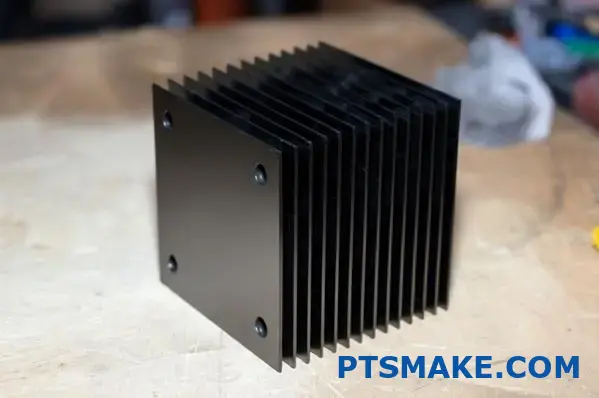
In my experience designing cooling solutions for high-power electronics, I’ve found that black anodized heat sinks can run 5-8°C cooler than bare aluminum in identical environments with limited airflow. This temperature difference can translate directly to extended component lifespan and improved reliability.
Effect on Thermal Contact Resistance
Surface finishing also affects the crucial interface between the heat-generating component and the heat sink. This interface, often managed with thermal interface materials (TIMs), is highly sensitive to surface characteristics:
Surface Roughness: Different finishes create varying degrees of microscopic roughness, affecting how well thermal interface materials conform to the surface.
Surface Hardness: Anodized surfaces are significantly harder than bare aluminum, which can affect the pressure distribution and contact patterns.
Surface Chemistry: Some finishes alter the chemical properties of the surface, potentially affecting long-term compatibility with certain thermal interface materials.
At PTSMAKE, we’ve observed that bare or machined aluminum surfaces often provide the best thermal interface performance, as they allow for maximum surface contact when proper thermal interface materials are used. However, this advantage is typically minor compared to the benefits of increased emissivity in overall system performance.
Influence on Airflow Dynamics
Surface treatments alter the surface roughness at both the macro and micro levels, affecting how air flows across the heat sink:
Boundary Layer Effects: Smoother surfaces (like polished aluminum) maintain laminar airflow longer, while rougher surfaces may promote earlier transition to turbulent flow.
Surface Friction: Rougher surfaces increase friction, potentially reducing airflow in forced convection systems but sometimes improving heat transfer in natural convection scenarios.
Fin Edge Effects: Surface treatments can subtly change the effective thickness and edge profile of fins, particularly important in high-density fin arrays.
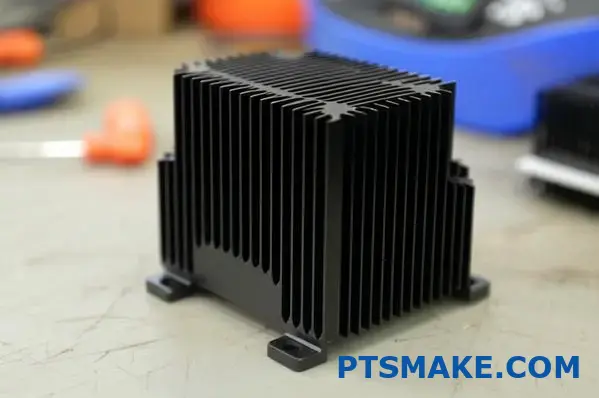
Comparing Different Surface Finishing Options
Bare Aluminum
Untreated aluminum offers the highest thermal conductivity at the surface but suffers from extremely low emissivity. It’s also prone to galvanic corrosion6 when in contact with dissimilar metals and develops a natural oxide layer over time that can be inconsistent.
Best for: Maximum conductive heat transfer in forced-air environments where radiation is minimal.
Anodized Surfaces
Anodizing creates a controlled, uniform oxide layer that provides:
- Clear Anodizing: Moderate improvement in emissivity while maintaining the metallic appearance.
- Black Anodizing: Dramatic improvement in emissivity (15-20× over bare aluminum).
- Colored Anodizing: Various emissivity improvements depending on color and process.
The anodic layer itself has lower thermal conductivity than aluminum (typically 1-2 W/mK vs. aluminum’s 237 W/mK), but at standard thicknesses of 5-25 microns, the impact on overall thermal performance is minimal compared to the emissivity benefits.
Best for: General-purpose applications, especially where radiative heat transfer is significant or cosmetic appearance matters.
Powder Coated Surfaces
Powder coating provides excellent emissivity (0.90-0.95 for black) but adds a thicker layer (typically 50-100 microns) that introduces more thermal resistance than anodizing. However, it offers superior corrosion protection and aesthetic options.
Best for: Outdoor applications or environments with chemical exposure where corrosion resistance is critical.
Chemical Conversion Coatings
Treatments like chromate conversion create thin protective layers with moderate emissivity improvements. These coatings offer good electrical conductivity (unlike anodizing, which is insulating) and minimal dimensional change.
Best for: Applications requiring electrical conductivity of the heat sink surface or where tight dimensional tolerances must be maintained.
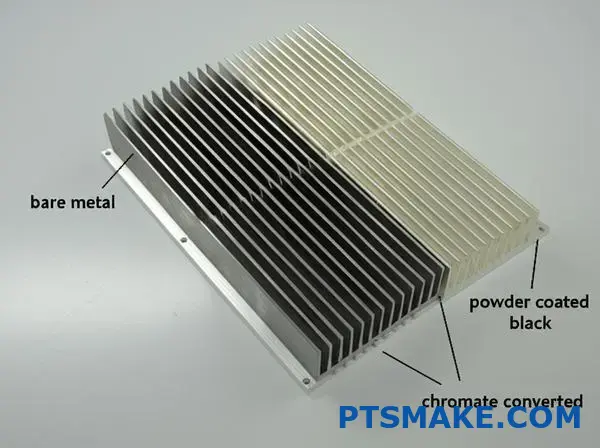
Application-Specific Considerations
LED Lighting
For LED applications, surface finishing plays a crucial role:
Black anodizing is often optimal for passive cooling designs, as the high emissivity compensates for limited airflow in enclosed fixtures.
Clear anodizing provides a good balance when aesthetic considerations require maintaining the metallic appearance of the heat sink.
For outdoor LED fixtures, powder coating might be preferred despite its slightly lower thermal performance, as it offers superior weathering resistance.
Computer and Electronics Cooling
In computing applications:
Black anodizing is preferred for passively cooled components like motherboard heat spreaders and low-power CPU heat sinks.
Clear anodizing or bare aluminum may be used in actively cooled systems where forced air diminishes the importance of radiative heat transfer.
For high-performance computing, custom surface treatments might combine machined contact patches (for optimal component interface) with anodized outer surfaces.
Power Electronics
For high-power applications like inverters, motor drives, and power supplies:
Black anodizing typically offers the best overall performance, especially for natural convection cooling.
Bare aluminum might be maintained at critical contact points while the rest of the heat sink is anodized.
In high-temperature applications (>90°C), the radiative benefit of high-emissivity surfaces becomes even more pronounced.
Manufacturing and Cost Considerations
Surface finishing adds cost and processing time to heat sink manufacturing, requiring careful cost-benefit analysis:
Bare Aluminum: Lowest cost, but may require deburring and cleaning processes after machining.
Anodizing: Adds approximately 15-25% to the base cost but significantly improves performance and appearance.
Powder Coating: Typically increases cost by 20-35% but offers the most durable finish for harsh environments.
Chemical Conversion: Moderate cost increase (10-15%) with modest performance benefits.
At PTSMAKE, we often recommend black anodizing as the most cost-effective surface treatment for optimizing thermal performance. The slight cost increase is typically justified by the substantial performance improvement, particularly in natural convection applications.
Optimizing Heat Sink Design for Surface Finishing
To maximize the benefits of surface finishing, heat sink design should account for the intended surface treatment:
Fin Density and Spacing: High-emissivity finishes like black anodizing allow for slightly higher fin density in passive cooling designs.
Contact Surface Design: Consider maintaining bare aluminum or applying thinner anodizing at critical component interfaces.
Edge Effects: Account for the dimensional changes from surface treatments when designing tight-tolerance features.
Thermal Interface Material Selection: Choose TIMs that are compatible with the selected surface finish for long-term reliability.
For complex thermal management challenges, I recommend a holistic approach that considers not just the heat sink material and geometry, but also the surface finishing as an integral part of the thermal design strategy.
What Are the Cost-Efficiency Advantages of Aluminum Heat Sinks?
Have you ever found yourself balancing performance needs against budget constraints when selecting cooling solutions? Or wondered why aluminum heat sinks dominate the market despite copper’s superior thermal properties? The decision isn’t just about performance—it’s about finding that sweet spot where cooling capability meets economic reality.
Aluminum heat sinks offer exceptional cost-efficiency through their lower material cost (50-70% less than copper), excellent manufacturability, reduced weight, corrosion resistance, and versatile design options. While not matching copper’s thermal conductivity, aluminum’s practical advantages make it the economically sound choice for most thermal management applications, delivering the optimal balance of performance and value.
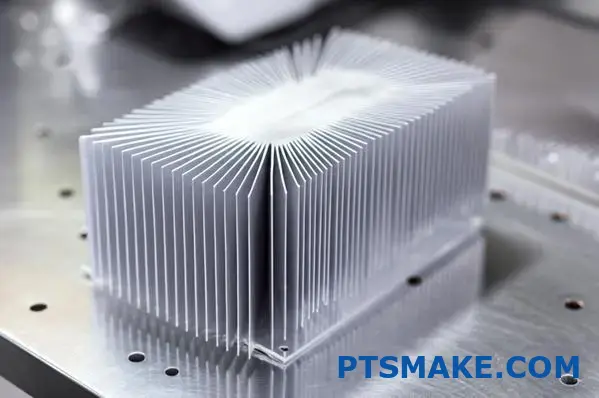
Understanding the Economic Factors of Heat Sink Materials
When evaluating heat sink materials from a cost-efficiency perspective, several factors beyond the simple purchase price must be considered. These include material costs, manufacturing complexity, weight considerations, and lifecycle expenses.
Material Cost Comparison
Aluminum’s fundamental cost advantage begins with the raw material. Let’s compare the primary heat sink materials by cost and performance:
| Material | Thermal Conductivity (W/mK) | Relative Material Cost | Density (g/cm³) | Manufacturability |
|---|---|---|---|---|
| Aluminum | 237 | Low (Base reference) | 2.7 | Excellent |
| Copper | 400 | High (3-4× aluminum) | 8.96 | Good |
| Aluminum Nitride | 170-200 | Very High (8-10× aluminum) | 3.26 | Limited |
| Carbon-based Materials | 100-500 | Extremely High (10-20× aluminum) | 1.5-2.2 | Complex |
This cost differential creates a significant competitive advantage for aluminum heat sinks, especially in price-sensitive markets and high-volume applications. The raw material savings alone can reduce overall product costs substantially.
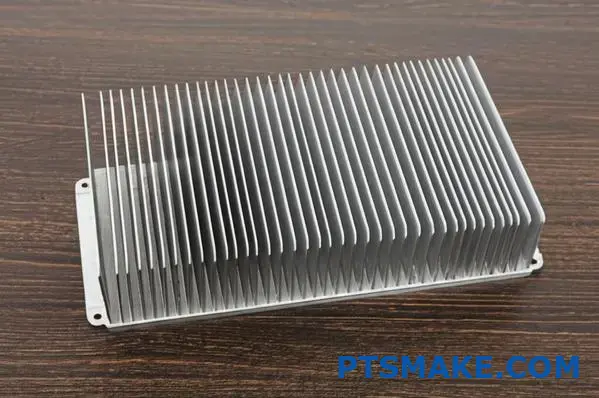
Manufacturing Cost Advantages
Aluminum’s excellent workability translates directly into manufacturing cost savings through multiple channels:
Extrusion Efficiency: Aluminum can be extruded into complex profiles at high speeds, creating intricate fin structures in a single operation. This process is significantly more cost-effective than machining the same geometry.
Machining Speed: When CNC machining is required, aluminum can be processed 3-5 times faster than copper, with less tool wear and longer machine uptime.
Finishing Options: Aluminum is compatible with cost-effective surface treatments like anodizing, which provides both aesthetic and functional benefits without excessive cost.
At PTSMAKE, we’ve found that manufacturing complex aluminum heat sinks typically costs 40-60% less than equivalent copper designs. This manufacturing advantage compounds the material cost savings, making aluminum the clear economic choice for most applications.
Weight-Related Economic Benefits
The weight difference between aluminum and copper heat sinks (with aluminum being roughly one-third the weight of copper) creates several cascading economic benefits:
Shipping Costs: Lower weight translates directly to reduced shipping expenses, especially important in today’s environment of rising freight costs.
Installation Expenses: Lighter components require less robust mounting hardware and less labor during installation.
Structural Support Requirements: Products using aluminum heat sinks often need less internal structural reinforcement, reducing overall material costs.
For one electronics manufacturer we worked with, switching from copper to aluminum heat sinks in their server products reduced shipping costs by 12% and assembly time by 15%, creating significant savings across their production volume.
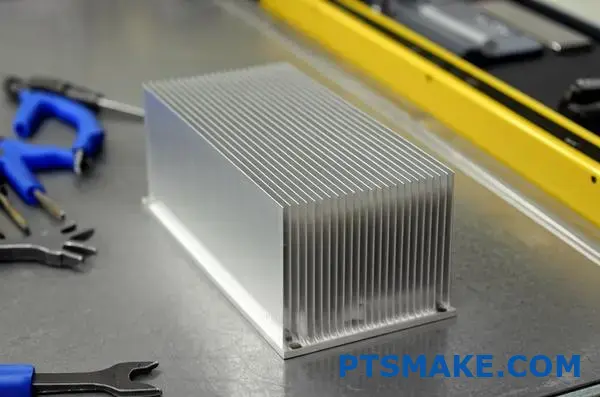
Design Flexibility and Cost Optimization
Aluminum’s manufacturing versatility enables cost-optimized thermal designs that may actually outperform simpler copper solutions despite aluminum’s lower thermal conductivity:
Enhanced Surface Area Economics
The ability to create more complex fin structures with aluminum allows designers to compensate for the lower thermal conductivity by increasing surface area. This often results in better real-world performance than a simpler copper heat sink at a fraction of the cost.
For example, an extruded aluminum heat sink with optimized fin density might provide:
- 40-50% more surface area than a comparable copper design
- Better overall thermal performance despite the material disadvantage
- 60-70% cost savings compared to the copper alternative
Integration Capabilities
Aluminum heat sinks can often incorporate mounting features, cable management, and other functional elements directly into the extrusion or casting process. This integration eliminates separate parts and assembly steps, reducing overall product costs.
Lifecycle Cost Considerations
The economic advantages of aluminum extend throughout the product lifecycle:
Corrosion Resistance: Aluminum naturally forms a protective oxide layer, requiring less maintenance and replacement in many environments compared to untreated copper, which can tarnish and degrade.
Recyclability: Aluminum’s recyclability (requiring only 5% of the energy to recycle compared to primary production) creates end-of-life value and supports sustainability initiatives that are increasingly economically important.
Modification Flexibility: The ease of machining aluminum allows for cost-effective modifications or customizations after initial production, providing flexibility that would be expensive with other materials.
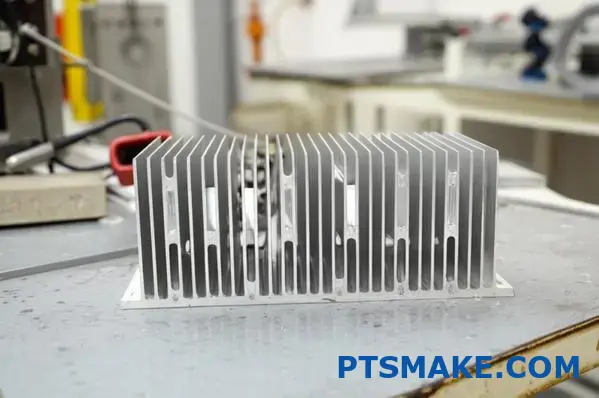
Application-Specific Cost Efficiency
Consumer Electronics
In consumer electronics—where margins are tight and volumes are high—aluminum heat sinks provide the ideal balance of performance and cost. The combination of material savings, manufacturing efficiency, and weight reduction can improve product margins by 3-5% compared to copper alternatives.
LED Lighting
The LED lighting industry has embraced aluminum heat sinks almost exclusively due to their cost efficiency. A typical LED light fixture might require:
- Large surface area for passive cooling
- Complex geometries to fit space constraints
- Lightweight design for ease of installation
Aluminum satisfies all these requirements at a price point that keeps LED lighting competitive in the marketplace.
Automotive Applications
In automotive thermal management, aluminum’s cost advantages become even more pronounced due to:
- High production volumes amplifying material cost savings
- Weight reduction contributing to fuel efficiency
- Excellent vibration damping properties reducing long-term failures
Real-World Cost-Efficiency Analysis
To illustrate the comprehensive cost advantages of aluminum, consider this comparison for a typical mid-sized heat sink used in power electronics:
Material Costs:
- Aluminum: Base reference
- Copper: 300-400% higher
Manufacturing Costs:
- Aluminum extrusion: Base reference
- Copper machining: 150-200% higher
Transportation Costs per Unit:
- Aluminum: Base reference
- Copper: 200-300% higher due to weight
Installation/Assembly Costs:
- Aluminum: Base reference
- Copper: 20-30% higher due to handling requirements
The total economic impact shows that copper heat sinks typically cost 2.5-3.5 times more than aluminum alternatives when all factors are considered. This cost differential rarely justifies copper’s thermal conductivity advantage except in the most thermally demanding applications.
Future Trends in Cost-Efficient Thermal Management
The cost-efficiency advantages of aluminum continue to evolve with new developments:
Advanced Alloys: New aluminum alloys are being developed with enhanced thermal properties while maintaining cost advantages.
Hybrid Solutions: Cost-optimized designs using aluminum with strategic copper components only where absolutely necessary represent the future of cost-efficient thermal management.
Additive Manufacturing: As 3D printing of aluminum becomes more cost-effective, new geometries previously impossible to manufacture economically will further enhance aluminum’s thermal performance relative to its cost.
The economic advantages of aluminum heat sinks are likely to increase rather than diminish as these technologies mature, further cementing aluminum’s position as the most cost-efficient thermal management material for most applications.
How to Choose the Right Aluminum Heat Sink for Industrial Applications?
Have you ever watched a critical industrial system shut down unexpectedly due to overheating? Or struggled with electronic components failing prematurely despite your best engineering efforts? Selecting the proper heat sink isn’t just a technical decision—it’s one that can determine whether your industrial equipment thrives or fails in demanding environments.
The right aluminum heat sink for industrial applications should match your specific thermal requirements, environmental conditions, and space constraints. Select 6061-T6 alloy for structural strength, 6063-T5 for complex extrusions, or 1050A for maximum thermal conductivity. Consider anodized finishes for corrosive environments, and optimize fin design based on available airflow. The ideal heat sink balances thermal performance with practical constraints.
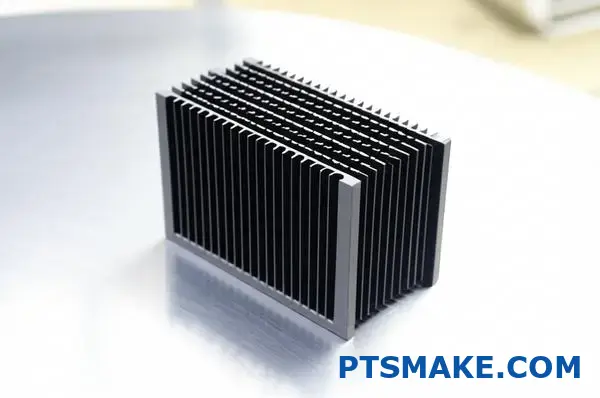
Key Factors in Industrial Heat Sink Selection
Choosing the right aluminum heat sink for industrial applications requires a systematic approach that considers multiple factors beyond simple thermal conductivity. Industrial environments present unique challenges including temperature extremes, vibration, contamination, and often continuous operation requirements.
Thermal Load Analysis: Starting with the Fundamentals
Understanding your thermal dissipation requirements forms the foundation of any heat sink selection process. This involves:
- Heat Source Characterization: Precisely quantify the heat output of your components under maximum load conditions.
- Thermal Budget Calculation: Determine the maximum allowable temperature rise for your components.
- Ambient Conditions Assessment: Consider the full range of ambient temperatures your equipment will experience.
| Heat Load Range | Recommended Heat Sink Type | Optimal Fin Design |
|---|---|---|
| Low (<50W) | Passive, stamped or extruded | Wide-spaced, thicker fins |
| Medium (50-200W) | Extruded with optimized fin density | Medium-spaced, balanced thickness |
| High (200-500W) | Extruded with integrated pipes or liquid cooling | Highly dense, thin fins with forced air |
| Very High (>500W) | Liquid-cooled systems or vapor chambers | Custom designs beyond standard air cooling |
I’ve found that many engineers underestimate their thermal requirements by considering only typical operating conditions rather than worst-case scenarios. At PTSMAKE, we recommend adding a 30% safety margin to calculated thermal loads to account for unexpected operational variations and component degradation over time.
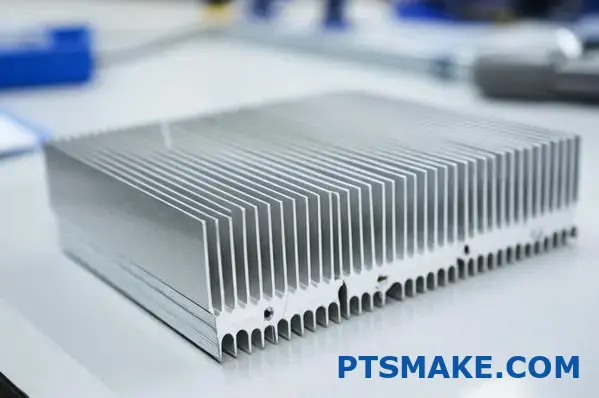
Airflow Considerations in Industrial Environments
Industrial settings have widely varying airflow conditions that significantly impact heat sink performance:
Natural Convection Environments: In sealed enclosures or hazardous locations where fans cannot be used, the heat sink must operate efficiently with only natural airflow.
Restricted Airflow Zones: Many industrial cabinets have limited airflow due to dust filters, tight spacing, or complex internal structures.
Forced Air Systems: When fans or blowers are available, the heat sink design should be optimized for the specific airflow direction and volume.
For natural convection applications, I recommend widely spaced fins with greater height to maximize air movement through the heat sink. In contrast, forced-air applications can utilize densely packed fins that would be ineffective in natural convection scenarios.
Environmental Challenges in Industrial Settings
Industrial environments typically present more severe conditions than commercial or consumer applications:
Chemical Exposure: Industrial settings often involve exposure to oils, solvents, cleaning agents, and process chemicals.
Particulate Contamination: Dust, metal particles, fibers, and other contaminants can accumulate between fins, reducing cooling efficiency.
Vibration and Mechanical Stress: Industrial equipment frequently experiences significant vibration that can cause fatigue failure in improperly designed heat sinks.
Thermal Cycling: Many industrial processes involve heating and cooling cycles that stress the thermal interface between components and heat sinks.
For these challenging environments, I typically recommend anodized aluminum heat sinks. The anodizing layer provides excellent chemical resistance while also improving emissivity, which enhances radiative heat transfer. For extremely corrosive environments, black anodizing offers the best combination of protection and thermal performance.
Selecting the Optimal Aluminum Alloy
The choice of aluminum alloy significantly impacts both thermal performance and mechanical properties of your heat sink:
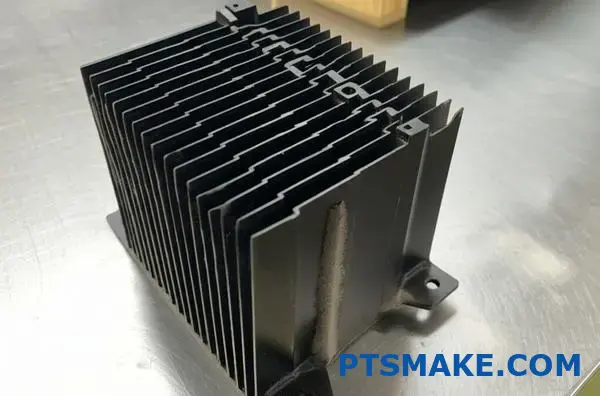
6061-T6: The Workhorse Alloy
6061-T6 offers excellent mechanical properties with good thermal conductivity (167 W/mK). Its advantages include:
- Superior strength and rigidity for larger heat sinks
- Excellent corrosion resistance
- Good machinability for complex features
- High resistance to stress and vibration
This alloy is ideal for industrial applications requiring structural integrity alongside thermal performance, such as motor drives, power supplies, and control systems subjected to vibration or mechanical stress.
6063-T5: The Extrusion Specialist
With higher thermal conductivity (209 W/mK) and excellent extrudability, 6063-T5 allows for:
- Complex fin geometries with thin walls and tight spacing
- More surface area per unit volume
- Lighter weight structures
- Cost-effective manufacturing for medium to high volumes
I often recommend 6063-T5 for applications where maximizing surface area is critical, such as in sealed enclosures relying on natural convection or in space-constrained industrial equipment.
1050A: Maximum Thermal Performance
For applications where thermal conductivity is the absolute priority, 1050A aluminum (229-235 W/mK) offers:
- Nearly pure aluminum composition (99.5%)
- Maximum thermal conductivity among common aluminum alloys
- Good corrosion resistance
- Lower mechanical strength than 6000-series alloys
This alloy is particularly valuable for high-power density applications where heat must be quickly conducted away from sensitive components, though its lower strength may require design accommodations.
Optimizing Heat Sink Geometry for Industrial Applications
The physical design of an industrial heat sink must balance thermal performance with practical limitations:
Base Thickness Considerations
The heat sink base serves as the primary thermal spreader and requires careful optimization:
- Too Thin: Creates hot spots and uneven heat distribution
- Too Thick: Adds unnecessary weight and material cost
- Optimal Range: Typically 4-10mm depending on heat source size and distribution
For concentrated heat sources like high-power IGBTs or industrial processors, I recommend a slightly thicker base (6-10mm) to ensure adequate heat spreading before reaching the fins.
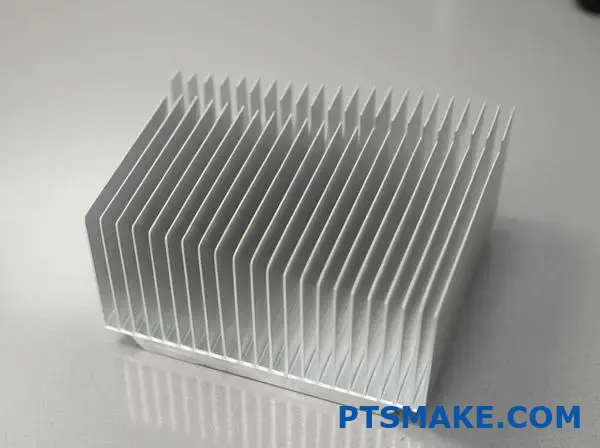
Fin Design Optimization
Fin geometry dramatically impacts cooling performance and must be matched to the specific application conditions:
Fin Height: Taller fins provide more surface area but become less effective beyond certain heights due to thermal resistance along the fin.
Fin Thickness: Thinner fins allow for higher fin density but may have reduced efficiency and structural issues.
Fin Spacing: The optimal spacing depends on airflow conditions—wider for natural convection, narrower for forced air.
Fin Shape: Straight fins work well for unidirectional airflow, while pin fins excel in multidirectional or turbulent airflow environments.
For industrial control cabinets with minimal airflow, I’ve found that fin spacings of 8-10mm provide the best balance between surface area and natural convection efficiency. In contrast, for applications with dedicated cooling fans, spacings of 2-3mm maximize surface area without restricting airflow.
Mounting and Interface Considerations
The thermal interface between the heat sink and component is often the weakest link in the thermal path:
Flatness and Surface Finish: Industrial-grade heat sinks should maintain a flatness tolerance of ≤0.001" per inch to ensure good thermal contact.
Mounting Pressure: Insufficient pressure creates air gaps that dramatically reduce thermal transfer efficiency.
Thermal Interface Materials: The right TIM for industrial applications should withstand vibration, temperature cycling, and aging without degradation.
Attachment Methods: Consider serviceability, vibration resistance, and thermal expansion when selecting between threaded fasteners, clips, or adhesive mounting.
Surface Treatments for Enhanced Industrial Performance
Raw aluminum heat sinks rarely provide optimal performance in industrial settings. Surface treatments offer significant advantages:
Anodizing Benefits Beyond Aesthetics
Anodizing creates a hard, electrically insulating oxide layer that provides:
Corrosion Resistance: Critical for humid, chemically active, or outdoor industrial environments.
Improved Emissivity: Black anodizing increases emissivity from 0.05 (bare aluminum) to 0.85-0.90, significantly enhancing radiative heat transfer.
Surface Hardness: Anodized surfaces resist scratches and abrasion that could otherwise compromise thermal performance over time.
Electrical Isolation: In industrial power electronics, the insulating properties of anodizing can prevent unwanted electrical paths.
For most industrial applications, I recommend Type II (sulfuric acid) anodizing with a thickness of 10-25 microns as the optimal balance between protection and thermal performance.
Alternative Surface Treatments
Other surface treatments offer specialized advantages for specific industrial conditions:
Powder Coating: Provides excellent chemical resistance for extremely harsh environments, though at some cost to thermal performance.
Chromate Conversion: Offers good electrical conductivity while providing moderate corrosion protection.
Chemical Film Treatments: Create minimal dimensional change while providing basic protection.
Integration with Active Cooling Systems
Many industrial applications require active cooling to meet thermal requirements:
Fan Integration Considerations
When designing heat sinks for forced-air cooling:
Airflow Path Optimization: The heat sink geometry should create minimal pressure drop while maximizing air contact with fin surfaces.
Fan Failure Scenarios: Industrial systems often need to survive temporary fan failures without catastrophic overheating.
Dust Accumulation: Fins should be designed to minimize dust buildup, which can reduce airflow and insulate thermal surfaces.
Hybrid Cooling Approaches
For the most demanding industrial applications, hybrid cooling approaches may be necessary:
Heat Pipe Integration: Copper heat pipes embedded in aluminum heat sinks can dramatically improve heat spreading from concentrated sources.
Vapor Chamber Bases: For extremely high power density applications, aluminum heat sinks with vapor chamber bases provide superior heat spreading.
Liquid Cooling Channels: Integrated liquid cooling passages can handle heat loads beyond the capabilities of air cooling while using aluminum’s excellent manufacturability7 advantages.
Making the Final Selection
When selecting the optimal aluminum heat sink for your industrial application, I recommend this systematic approach:
Define Requirements: Clearly establish thermal, mechanical, environmental, and economic constraints.
Shortlist Options: Identify heat sink designs that meet your thermal requirements under worst-case conditions.
Validate Performance: Use thermal modeling or prototype testing to verify performance before final implementation.
Consider Lifecycle Factors: Evaluate maintenance needs, long-term reliability, and end-of-life considerations.
Optimize Total Cost: Look beyond initial purchase price to include installation, maintenance, and operational efficiency.
By following this structured approach, you can select an aluminum heat sink that not only meets your immediate thermal management needs but also delivers reliable performance throughout your industrial system’s operational life.
Learn how extrusion techniques can dramatically improve your heat sink performance. ↩
Discover how advanced thermal dissipation technologies can reduce your device temperatures by up to 30%. ↩
Explore advanced techniques to minimize thermal resistance and improve your cooling system efficiency by up to 40%. ↩
Discover how phase-change materials can revolutionize your LED cooling performance. ↩
Learn how condensation cycles affect your heat sink’s long-term performance and reliability. ↩
Explore how to prevent galvanic corrosion in your heat sink designs while maintaining optimal thermal performance. ↩
Learn about advanced manufacturing techniques that can reduce your heat sink costs while improving performance. ↩



